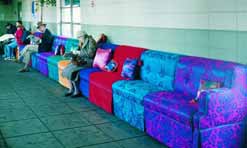
Virgil Marti, Couch
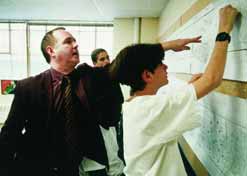
Tim Rollins and K.O.S., Amerika: For the People of Narberth
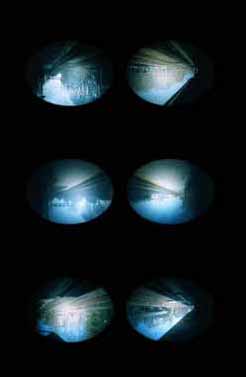
Richard Torchia, Sixteen Vanishing Points (and Passages Between)
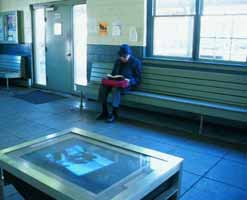
Dennis Adams, Retake
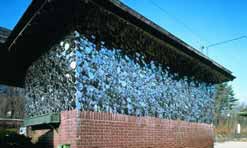
Susie Brandt, Glint
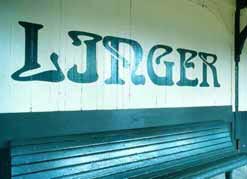
Kay Rosen, Lounge
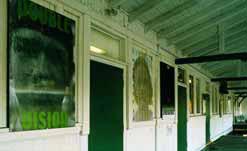
Don Adams, What do you Want? It's only a Question.
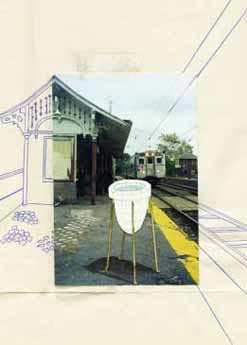
Maria Elena Gonzalez, watering (holes)
Points of departure: Art on the line
When Judy Herman of the Main Line Art Center invited me to think about doing something on the Main Line, my initial reaction was unenthusiastic. I couldn’t envision doing “plop art” but since Judy invited me based on Prison Sentences: The Prison as Site, The Prison as Subject I thought for a minute after I said I wasn’t interested, and then, “Unless it’s in the train stations” fell out of my mouth. One of the criteria of my projects is accessibility and exposure. The audience is very important to me. When I thought about the train stations the thought of the captive audience five days a week was thrilling. My father rode the train every day from Merion Station to Center City and I thought of him as a model — an intelligent person who doesn’t know the first thing about contemporary art, but who, after looking at it day after day, would finally gain an appreciation of the work. The idea of this captive audience of commuters discussing contemporary art was intoxicating.
We had a lot of time for research and development, engaging with the communities, and creating and installing the pieces. It was luxurious to have such a time frame. The project was awarded a grant from the Philadelphia Exhibitions Initiative in its first year of grant giving.
The communities on the Main Line are diverse; the artists each conducted their own brand of research.
Susie Brandt planned to work at Merion Station and she was inspired to make Glint as a reflection of work of the Pointillists at the Barnes Foundation. Glint was an eye- popping, ever-changing animated texture covering of the whole outbound building. Using mirror-like disks which were loosely mounted, they moved and changed constantly, like the flickering sequined signs of used car lots.
Tim Rollins + K.O.S. chose Narberth Station because there was a history of kids roughhousing at the station and terrorizing older people as they whizzed by on their skateboards. Tim worked with those very kids. They painted a mural, Amerika: For the People of Narberth on both walls of the tunnel under the tracks. Amerika by Franz Kafka is one of Tim’s favorite books to work with because there are so many points for the kids to relate to, although that’s not immediately apparent to them. However they engaged completely and the piece wasn’t vandalized in the 2 years it was installed.
Dennis Adams chose Bryn Mawr Station, the most quintessential Main Line community, he felt. He made a piece using stills from “The Young Philadelphians,” with Paul Newman, and installed a huge, sculptural monitor on its back in the station. Retake was a film he made of his hand handing out the stills at a busy corner in Philadelphia.
Kay Rosen decided to work at Wynnewood Station which was the least restored, and therefore, most Victorian of all the stations. The outbound waiting room had a long bench. She decided to make another bench and then painted “Linger Longer”, each word over one bench. The word “Longer” is a few inches longer than the word “Linger” and she made the bench a few inches longer than the original one. The notion of Lounge was to suggest people take time to relax and reflect. Commuters, especially those on their way home, are always in such a hurry.
Maria Elena Gonzalez was moved by the Hassidic community who came to perform a ritual at the creek near Overbrook Station on Sabbath and holidays. She realized that almost every religion has some kind of ritual that has to do with water and cleansing, and she created watering hole(s), two urns made of pristine glass tile that stood on the platform of each side of the tracks.
Don Camp worked with students from The Haverford School and The Baldwin School, two single sex private schools. “What do you want? It’s only a question”, consisted of seven large-scale portraits of the students which they digitally manipulated with poems and drawings of their personal thoughts. The portraits were mounted on the walls at Haverford Station. Caught at a time of personal evolution and intense questioning, their images evoked gender identity and role issues that are especially intense during the teen years.
At the most dreary station, Ardmore, Virgil Marti installed Couch, a multi-colored upholstered couch that covered the station’s 30 foot long waiting room bench. He silkscreened cushions and covered the bench in brocades and velvets. It was ravishing and the commuters were really sad to see it go. Every time I walked into the cinder block station I burst out laughing at the incongruous sight of it.
Richard Torchia placed a camera obscura that was equipped with two lenses. at each of the eight stations. Sixteen Vanishing Points (and Passages Between) focused on the points where the inbound and outbound tracks disappear from view. You could watch the train wrap around the station, and because the image is inverted, the train is upside down and backward. Torchia was inspired by the Lumiere brother’s 1895 film L’Arrivee d’un Train en Gare.
